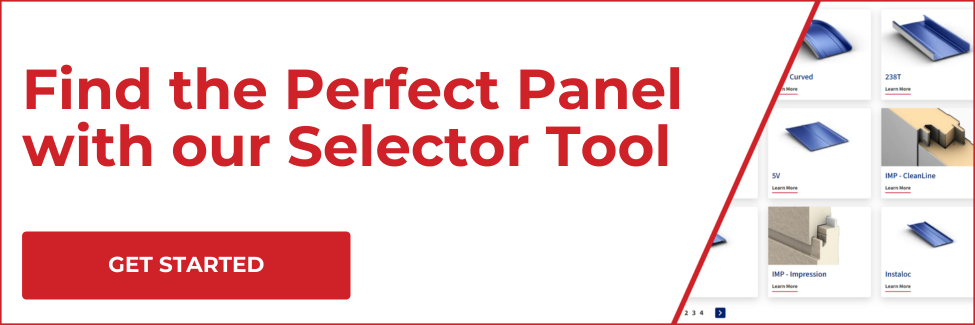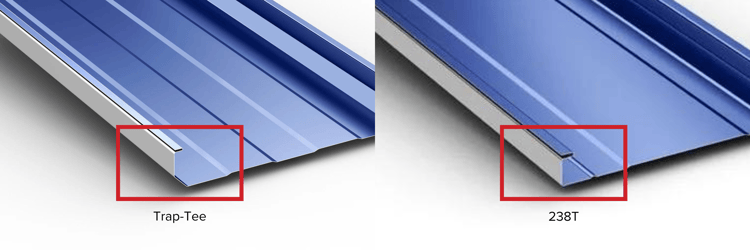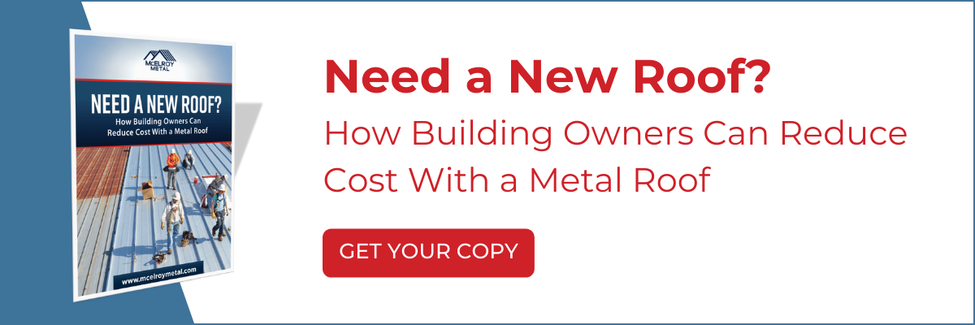Quick Guide to Metal Warehouse Roofing
Choosing the best metal roof for a warehouse depends on several factors—from the size and slope of the building to what’s stored inside and how energy-efficient the facility needs to be.
Warehouse Roofing Considerations
Most warehouses share key design traits—large footprints and low-slope roofs—that make metal roofing an ideal solution. Metal panels accommodate long spans efficiently, and their proven durability often outlasts the building itself, with many systems performing reliably for 60 years or more. Because of the expansive roof areas typical of warehouse construction, wider panel systems can also help reduce installation time and overall project cost.
It's also important to realize the low slope of most warehouse roofs causes the roof to shed water more slowly, which can allow water to submerse the panel before reaching a gutter to drain. A standing seam and tall depth metal roofing system (238T or 3” trapezoidal panel) can help to accommodate the more considerable water depths.
Warehouses also tend to have long panel runs, so panel systems that can accommodate thermal expansion are advantageous.
Another consideration is what the warehouse will be used to store. Cyber companies storing billions of dollars of electrical systems will be more willing to spend significant dollars on the building and a more weather-tight roof than a company that stores less sensitive materials.
Metal Warehouse Roofing
The specific building application and design specifications should be considered when selecting a roofing system.

In general, however, many warehouse owners elect a 3” trapezoidal panel. These are widely available in 24” widths and have a tall standing seam that holds the seam well above the potential flood plain. Furthermore, they are available in snap or mechanically seamed varieties.
Although roofs with numerous valleys may not be good candidates for trapezoidal panels.
Also popular are T-panel systems such as our 238T, available in 24” width and with a 2 3/8” tall seam.
A few other pre-installation tips:
- Avoid panel laps by onsite forming using 238T and Trap-Tee - especially for panel runs over 60'
- Avoid MasterLok-90 and other trapezoidal panel styles for projects with valley conditions
- Panel replacement and repair is straightforward for 238T and Trap Tee type panels
- Avoid internal gutters
- Always select an experienced/qualified contractor

McElroy Metal Warehouse Roofing Solutions
Depending on project specifics, we recommend one of three different products for warehouse roofing: the MasterLok-90 family of products, the new Trap-Tee system, and our 238T.
The MasterLok-90 product line and other nonsymmetrical trapezoidal-style panels have been a long-standing workhorse for warehouse projects. This panel style often boasts a 24" width, which makes installation quick.
The downside to nonsymmetrical trapezoidal panel styles involves repairability and weather integrity. Due to the nonsymmetrical design of the panel leg, it can be very challenging (if not impossible) to repair or replace single panels in the field of the roof.
Additionally, this panel style is typically unavailable as a job site-produced panel, which limits single-piece panel lengths to around 60' and requires panel laps for runs greater than 60'. Panel laps for these products are labor-intensive to install and often represent a source of leaks as the roofing system ages. Consequently, nonsymmetrical panel systems, like our MasterLok-90 product family, are best suited for warehouse projects with runs below 60' that do not include hips or valleys.
While the MasterLok-90 family of products can provide an excellent warehouse roofing solution for simple box buildings with panel lengths below 60', our Trap Tee is a better solution for larger or more complicated roof plans.
McElroy's 2 3/4" tall symmetrical Trap-Tee system is a site-formed, mechanically seamed system designed to resolve the three major shortcomings of trapezoidal standing seam roof systems: leaking end laps, low wind uplift capacity, and repair challenges.
By forming the panels on-site, we can produce a single-length panel over 250' long, eliminating the time and expense of a lap condition. However, perhaps more importantly, single-piece panels virtually eliminate leak potential at the lap—because there is no lap. Beyond enhanced weatherability, our Trap-Tee panel offers unsurpassed uplift capacity and a symmetrical design to accommodate individual panel replaceability in the field of the roof. Since metal roofs can easily last 60 years, and warehouse requirements can change significantly during the roofing system lifespan, it's critical to consider the ability to repair or replace individual roofing system components when selecting roofing for warehouse applications.
McElroy's Trap-Tee standing seam system is a versatile panel that is equally well-suited for new construction, remove & replace, retrofit, and recover applications where the existing roof remains in place. With all of the great things our Trap-Tee panel offers, our 238T system remains the best solution for projects with hips and valleys.
The 238T system can also be onsite roll-formed in lengths up to 250' to improve weathertightness by eliminating end laps. It's also a symmetrical panel design, which allows for the repair or replacement of single-piece panels when building uses change over time and offers outstanding wind uplift.
The big difference between 238T and Trap-Tee involves the design where the two-panel legs join or butt up to each other. Trap-Tee is a trapezoidal panel; the 238T is considered a vertical leg panel.

Trapezoidal panels from all manufacturers can be incredibly challenging to make weathertight at hip and valley conditions. While our Trap-Tee product offers a greatly reduced trapezoidal shape, vertical leg panels like our 238T offer the best performance for projects with hips and valleys.
Roof Color and Energy Efficiency
Since most warehouse roofing is low slope, the roof isn’t typically visible from the ground. With few people looking at the roof, many building owners opt to forgo a paint system and instead choose bare Galvalume® to save money.
While there's nothing wrong with a bare Galvalume roof, some colors can help reduce energy bills.
When building owners choose a roof color with a high solar reflectance index (SRI) value, like white, the roof assembly remains cooler, and consequently, the HVAC system runs less often. So, while a paint color with a high SRI value will make the roof slightly more expensive up front, owners educated about the difference often opt for a colored roof to save energy costs.
If you would like to talk to a McElroy Metal representative about the low-slope roof application of metal roofing for warehouses, please click here to locate your rep.
About McElroy Metal
Since 1963, McElroy Metal has served the construction industry with quality products and excellent customer service. The employee-owned components manufacturer is headquartered in Bossier City, La., and has 14 manufacturing facilities across the United States. Quality, service and performance have been the cornerstone of McElroy Metal’s business philosophy and have contributed to the success of the company through the years. As a preferred service provider, these values will continue to be at the forefront of McElroy Metal’s model along with a strong focus on the customer.



.png?width=767&name=What%20to%20Expect%20When%20You%20Order%20From%20McElroy%20Metal%20(1).png)


.png?width=440&height=293&name=How%20to%20Install%20Metal%20Roofing%20Over%20Existing%20Metal%20Roofs%20(1).png)


Comments on this article:
Scroll down to the bottom to submit a comment and join the conversation. Need help or have a question? Please contact us. Looking for a distributor or contractor? Please click here to get started.